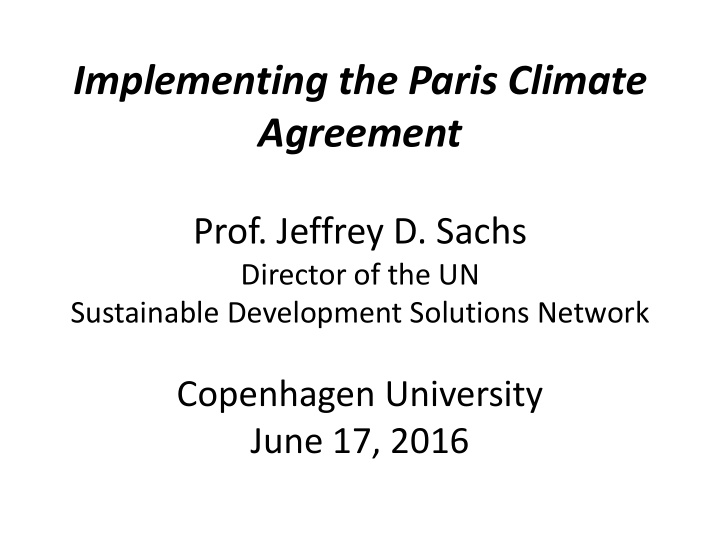



Implementing the Paris Climate Agreement Prof. Jeffrey D. Sachs Director of the UN Sustainable Development Solutions Network Copenhagen University June 17, 2016
THE WORLD HAS ENTERED THE AGE OF SUSTAINABLE DEVELOPMENT WITH THE ADOPTION OF THE SUSTAINABLE DEVELOPMENT GOALS AT THE UNITED NATIONS ON SEPTEMBER 25 2015 AND THE PARIS CLIMATE AGREEMENT ON DECEMBER 12 2015
SUSTAINABLE DEVELOPMENT MEANS ECONOMIC DEVELOPMENT THAT IS SOCIALLY INCLUSIVE AND ENVIRONMENTALLY SUSTAINABLE
THE SDGS WILL OPERATE DURING 2016-2030
Defining a Sustainable Development Trajectory to 2050 and 2100 Demography Economic Development Agriculture, Energy and the Planetary Boundaries Megacities Migration and World Regions in Crisis
World Population to 2100: UN Fertility Variants 18 16 14 12 10 Medium Variant 8 High Variant 6 Low Variant 4 2 0 1950 1961 1972 1983 1994 2005 2016 2027 2038 2049 2060 2071 2082 2093
HUMANITY IS VIOLATING THE “ PLANETARY BOUNDARIES ” Source: Rockström et al 2009a)
BAU: 4-6 degree C 2-degree C
HUMANITY IS VIOLATING THE “ PLANETARY BOUNDARIES ” Source: Rockström et al 2009a)
Sea Level in the Eamian
Land Lost to 6M Sea Level Rise, NASA
THE PARIS AGREEMENT Hold the increase in the global Average temperature “to well below 2° C” and “pursue efforts to limit the temperature increase to 1.5° C.
LONG-TERM LOW GREENHOUSE GAS EMISSION DEVELOPMENT STRATEGIES, ARTICLE 4, PARA 19 All parties should “formulate and communicate long-term low greenhouse emission development strategies” by 2020
Main Decarbonization Strategies Decarbonization of End Use Fuel Switching Energy Efficiency Energy Efficiency Electricity to Electric Sources Strategy Transformation Key Metric of 2014 2014 2014 2050 2050 2050 0% 25% 50% 75% 0 200 400 600 0,0 5,0 10,0 Share of Electricity and Electricity Emissions Energy Intensity of GDP Electric Fuels Intensity (gCO2/kWh) (GJ/$2005) in Total Final Energy (%)
DENMARK ENERGY STRATEGY 2050
THE DEEP DECARBONIZATION PATHWAYS PROJECT
Electricity Supply: By Fuel Type and Demand Sector Fossil Fossil (CCS) Nuclear ELECTRIC ELECTRIC Hydro 35 Geothermal SUPPLY DEMAND Biomass Final Energy in 2050 (EJ) SOURCES: SECTORS: Wind Solar 30 Intermediate Residential Commercial Energy Solar Transportation Carriers 25 Industrial Intermediate Energy Carriers Industrial 20 Wind Transportation Geothermal 15 Hydro Commercial 10 Nuclear 5 Fossil Residential w/CCS Fossil Generation 0 2014 2018 2022 2026 2030 2034 2038 2042 2046 2050
WHO’S RESERVES WILL BE STRANDED? FROM McGLADE AND EKINS, NATURE MAGAZINE, JANUARY 8, 2015
Some Principles for the Transition: Minimize Global Mitigation Costs, Across Countries And Over Time (Efficiency) Distribute Costs Equitably, According to Historical Responsibility, Damages, Ability To Pay, Ability to Adjust, Across Generations Adapt as well as Mitigate Manage Risks (insurance, resilience, and learning) Invest in R&D and Social Learning, Public and Private
Diverse Policy Instruments: Corrective Pricing (tax, permit) Choice of Technology (complexities of Nuclear, Wind, Solar, Hydro) Choice of Siting and Transmission Grids RDD&D and IP Policies Income Redistribution within, across generations
Key Principles for Long-Term Success Low-Emissions Development Strategies (LEDS) to 2050 Specialized Public Institutions for the Energy Transition Low-Carbon Technology Roadmaps and RDD&D: Renewables, Hydro, Nuclear, CCS Electric Vehicles, Electric Heating Use Regulation as Well as Pricing Phase out all Coal Without CCS End Arctic, deep-sea, oil sand exploration and development Plan to Strand High-Cost Hydrocarbons, with equity Use Cross-Border Grids and Systems “Smart” cities Climate Financing (especially GCF, GEF, MDBs)
LOW-EMISSIONS SOLUTIONS CONFERENCE AT COP 22 on November 12-16, 2016 Co-Hosted By the Government of Morocco with: UN Sustainable Development Solutions Network World Business Council on Sustainable Development (WBCSD) Local Governments for Sustainability (ICLEI)
The World in 2050 Initiative Hosted at the International Institute For Applied Systems Analysis (IIASA) With: Earth Institute Potsdam Institute for Climate Impact Research Stockholm Resiliency Institute PBL Netherlands Environmental Assessment Agency And many others!
THE SDSN GLOBAL NETWORK
Recommend
More recommend